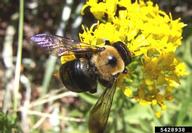More and more homeowners and small-gardeners are choosing to reduce or end their use of pesticides. Not just for the health of their family and pets, but to reduce the risk of harming pollinators. Growers and farmers have multiple reasons to reduce pesticide use: reduced cost, reduced health risk to their families and employees,…Continue Reading Pollinator Protection Resources
In praise of messiness
PUBLISHED ON SEPTEMBER 26, 2017 | Courtesy Paul Hetzler, CCE St. Lawrence County KEMPTVILLE, ONTARIO. — On my twice-monthly drive on Highway 416 between Prescott and Ottawa, I pass the sign for Kemptville, a town of about 3,500 which lies roughly 40 km north of the St. Lawrence. It has a rich history, and no…Continue Reading In praise of messiness
Get Rid of Carpenter Bees? Yes, Please!
Carpenter bees are common spring and summer insects in the eastern United States. They first come to attention when males “buzz” or “dive bomb” people passing by and females are seen excavating holes in wooden structures. Like carpenter ants, carpenter bees do not eat wood, but rather use the substrate for nesting. They are important…Continue Reading Get Rid of Carpenter Bees? Yes, Please!
All Buzz and No Sting
The sound of buzzing in our ears is one that evokes terror. Even as an entomologist, I can only stand the sound for a short time before I involuntarily swat at my winged assailant. If this is your reaction too – know that you’re not alone. Our distress over the buzzing of a flying insect,…Continue Reading All Buzz and No Sting
Don’t bee fooled

April can fool you all month long. Even if your pest-prevention responsibilities lie mostly indoors where frost and rain rarely intrude — a school, an office building, a museum, your home — April has some tricks up her sleeve. Those perimeter pests, for example: wasps, bees, ants, termites. For many species of wasps and bees,…Continue Reading Don’t bee fooled